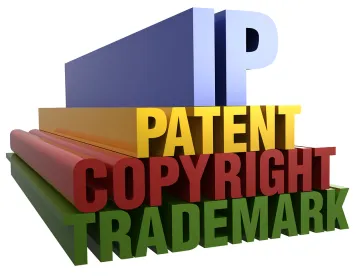While most Americans are likely aware that President Donald Trump signed a pandemic relief and government spending bill into law on Dec. 27, 2020 (the “Omnibus Bill”),[i] it is important for those who have intellectual property assets to understand that tucked away into this nearly 5,600-page legislation are laws impacting copyrights, trademarks, and patents. Despite receiving only limited scrutiny before becoming law, the copyright and trademark laws in particular could have a profound impact on protection and enforcement of these assets.
Copyrights
The Omnibus Bill impacts copyright law in the following general ways: It establishes a copyright small-claims court within the U.S. Copyright Office to adjudicate disputes valued at $30,000 or fewer in damages, and it creates felony criminal penalties for unauthorized commercial streaming.
The CASE Act. The Copyright Alternative in Small-Claims Enforcement Act of 2020 (the “CASE Act”)[ii] established the Copyright Claims Board, a quasi-judicial tribunal with three “Copyright Claims Officers” appointed by the librarian of Congress. The law empowers the Board to hear claims for copyright infringement, a declaration of noninfringement, misrepresentation of takedown notices and counter-notices, and all related counterclaims and defense (so long as all claims arise out of the same allegedly infringing activity or course of activities and do not exceed $30,000 in the aggregate).[iii] Participation is voluntary and defendants can opt out. Damages are capped at $15,000 per claim or $30,000 for the entire case.[iv]
The CASE Act was introduced and passed in the House last year but, until now, it had been held up in the Senate. Proponents of the CASE Act believe this new mechanism will enable more copyright holders to access the judicial system by providing an alternative to the more traditional copyright litigation in federal court. Critics, however, raise concerns that this new venue may have unintended consequences of (a) making it easier for big media companies to pursue damages from ordinary internet users and (b) being abused by “copyright trolls” or to silence free speech; or (c) being ineffective altogether because of the opt-out option. To deter abusive practices, the law includes a Bad Faith Conduct provision, which “direct[s]” the Board to award reasonable costs and attorney’s fees in the event it finds a party utilized the tribunal to harass or for other improper purposes[v] (and barring the period for 12 months for repeat offenses[vi]).
The Felony Streaming Act. The Felony Streaming Act[vii] makes the unauthorized commercial streaming of copyrighted material a felony (as opposed to its current status of a misdemeanor) to harmonize the penalty with the unlawful reproduction or distribution of copyrighted works.[viii] The bill imposes penalties for illegal large-scale sites that are “primarily designed to publicly perform unlicensed works without permission for financial gain and have no other ‘commercial significant purpose.’” It imposes the possibility of up to 10 years in prison for violators if the operator knew or should have known that the work was prepared for a commercial public performance.[ix]
Trademarks
The Trademark Modernization Act[x] includes three major changes to trademark law that will take effect at the end of 2021.
First, the law creates a process for third parties to challenge both applications and issued trademarks.
-
To challenge an application, at any time during the examination period, a third party may submit evidence to argue why the application should be refused.[xi] The director then has two months to determine whether the evidence should be included. The determination is final and non-reviewable.
-
To challenge a registered trademark, a third party can either petition for expungement or cancelation. [xii] In a petition for expungement, which can be filed against a mark that has been registered for at least three years and no more than 10, the petitioner must argue that the mark has never been used in commerce in connection with all or some of the goods and services listed in the registration.[xiii] (For three years from the Omnibus Bill’s enactment date, however, any mark that has been registered for three years or more is vulnerable to expungement.)[xiv] In a petition for reexamination, which can be filed anytime within five years from the registration date, the petitioner must argue that the mark was not in use on the relevant date, depending on the basis of the application.[xv]
On the one hand, this provision may provide an easier mechanism to clear the trademark register of improper registrations and make those marks available to legitimate actors. On the other hand, though, this law may create an opportunity for trademark opportunists to challenge registrations, just to turn around and re-apply for the mark even though they have no or little intention of using the mark either.
Second, the law provides the director of the U.S. Patent and Trademark Office the authority to reconsider, and modify or set aside, a decision from the Trademark Trial and Appeals Board (“TTAB”).[xvi] This change likely seeks to shield the TTAB judges from a constitutional challenge for a lack of oversight, as is pending before the Supreme Court for Patent Trial and Appeals Board judges in U.S. v. Anthrex, Inc.[xvii]
Third, the law establishes that trademark plaintiffs seeking an injunction are entitled to a rebuttable presumption of irreparable harm upon a finding of infringement (in the case of a permanent injunction) or demonstrates a likelihood of success on the merits (in the case of a preliminary injunction).[xviii] This presumption was once the standard for trademark cases, but when the Supreme Court ruled in eBay v. MercExchange[xix] in 2006 that patent plaintiffs are not entitled to this presumption, certain circuit courts have applied this holding to trademark owners creating inconsistency amongst the circuits.[xx]
While under this law, the accused infringer is able to rebut the presumption, i.e. present evidence that the trademark owner has not been harmed, the legislation is likely to pave the way for trademark owners to more easily get the competing product out of the market. It is also important to note that the law covers not only trademark cases, but all Lanham Act cases, so it includes false advertising and cybersquatting cases.
Patents
Lastly, the law requires the Food and Drug Administration’s Purple Book, which provides information about biologic drugs, to include information about the patents that cover the products.[xxi]
Dinsmore’s Intellectual Property Trademark/Copyright or Enforcement practice group members are available to advise and answer any questions about these new laws.
The full text of the Bill can be found here.
[i] Consolidated Appropriations Act of 2021, H.R. 113, 116th Cong. (2020).
[ii] Id. at Div. Q § 212, 77.
[iii] Id. at 90-91.
[iv] Id. at 79, 93. Statutory damages for cases involving works that were not timely registered are capped at $7,500 per work infringed, or a total of $15,000. Id. at 94.
[v] Id. at 124 (capping the award at $5,000).
[vi] Id. at 124-25.
[vii] Id. at § 211, 72.
[viii] Id. at 75-76; see also 17 U.S.C. § 506(a); 18 U.S.C. § 2319.
[ix] H.R. 113, Div. Q § 211, 75.
[x] Id. at §§ 221-28, 139-66.
[xi] Id. at § 223, 140.
[xii] Id. at § 223(a), 140-41.
[xiii] Id. at § 225(a) & (c), 143, 149. Both of these procedures may also be initiated by the director. Id. at § 225(a) & (c), 148, 156).
[xiv] Id. at § 225(a), 149.
[xv] Id. at § 225(c), 151, 157.
[xvi] Id. at § 228, 165.
[xvii] See Anthrex Inc. v. Smith & Nephew, Inc., 941 F.3d 1320 (Fed. Cir. 2019) (holding that the appointment of administrative patent judges to the Patent Trial and Appeals Board violates the Appointments Clause of the Constitution because the administrative patent judges are principal officers). The Supreme Court granted certiorari for Anthrex Inc. v. Smith & Nephew, Inc. on October 13, 2020 and consolidated it with two other cases as US v. Anthrex, Docket No. 19-1434. Oral arguments have not been scheduled.
[xviii] H.R. 113, Div. Q § 226, 160.
[xix] eBay v. MercExchange, 547 U.S. 388 (2006) (holding that a plaintiff is not entitled to a presumption of irreparable harm in granting an injunction based on a finding of patent infringement).
[xx] See, e.g., Commodores Entm't Corp. v. McClary, 648 F. App'x 771, 777 (11th Cir. 2016) (“In light of the Supreme Court's holding in eBay, a presumption of irreparable harm cannot survive.”); Ferring Pharm., Inc. v. Watson Pharm., Inc., 765 F.3d 205, 217 (3d Cir. 2014) (holding that a party seeking a preliminary injunction in a Lanham Act case is not entitled to a presumption of irreparable harm); Dalkita, Inc. v. Distilling Craft, LLC, 356 F. Supp. 3d 1125, 1133 (D. Colo. 2018) (holding that eBay abrogates the presumption of irreparable harm in trademark infringement cases in conformity with other the district courts in the Tenth Circuit); but see Phyllis Schlafly Revocable Tr. v. Cori, 924 F.3d 1004, 1009-10 (8th Cir. 2019) (declining to determine whether the presumption survived eBay because it did not apply); Abraham v. Alpha Chi Omega, 708 F.3d 614, 627 (5th Cir. 2013) (endorsing the presumption in a Lanham Act case but not requiring it).
[xxi] H.R. 113, Div. BB § 315, 2125.




 />i
/>i

